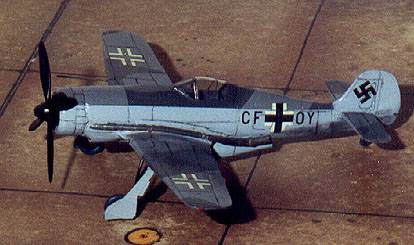
Kit: Fw-190v13
Scale: 1/72
Kit Number: ????
Manufacturer: ????
Price: approx $7.50
Media: Resin with a vacuformed canopy
Decals :none
Date of Review: 15 June 1997

Comments: This is one of several resins of unknown origin that I picked up at the Mildenhall Air Show in 1988. It came in a bag and that is about it. No instructions, drawings or decals.
The Fw-190 needs no real introduction to Luftwaffe fans. The v13 is one of several prototypes designed to test the possibility of supercharging or turbocharging the BMW radial engine. This capability was realized in several US aircraft; all of them rather large, the best known being the P-47D Thunderbolt. In the Fw-190, there was little room inside the airframe for all the ducting and the turbocharger, so this was accomplished by running the ducting outside the fuselage and having the turbocharger in a huge 'intake' under the aft fuselage.
With this resin kit, the airframe was basically in one piece with the turbocharger tub and propeller molded as additional large pieces and the rest of the bits (landing gear, gear doors, interior bits) in a large section of flash that was separately wrapped. The last resin kit reviewed suffered from major mold mismatch. That was not the case with this one although there were a lot of pinholes that needed filled (I used superglue for this one). There were also some cases of very large holes (unfortunately most of these were on the ducting) that needed major attention and putty. Once the bits were cleaned up, it was time for construction.
Construction was pretty straightforward and similar to a normal kit. The big difference being the need to use epoxy or superglue in construction. I found the cockpit tub to be too shallow so had to grind it out a bit with a motor tool. The interior parts were sufficient, although not up to an injected kit, and included the basics (seat, instrument panel and control stick). The vacuformed canopy was relatively thick, but easy to cut as the delineations were quite prominent. In addition, it fit very well. The other resin parts were rather thick and suffered form slight mold mismatch, resulting in the need to thin down some rather fragile parts. The landing gear was not reinforced with metal, so after a few years, the gear has bowed under the weight of the kit. This is a typical problem with resin. Resin is relatively soft. The positive means that it is easy to straighten out warped bits with tweaking under warm water. The negative is that it yields under prolonged stress; thus the problems with bowed landing gear.
Once the kit was built up and masked, it was time to look for markings. Since this is a prototype, there is actually only one set of marks that can be used. It was painted in typical Fw-190 scheme of 74/75/76 and national markings were scrounged from spares and other sources. As for unique markings, I used a Modeldecal sheet for the code letters CF+OY, which were placed on the fuselage sides and under the wings. Since I built this kit, there has been another on the market from MPM. I can imagine that it is probably a bit better; offering a decent interior as well as a proper decal sheet.
I enjoyed building this kit as it offered what resins offer best: a chance to build a rare subject without having to resort to vacuforms or massive kitbashing.